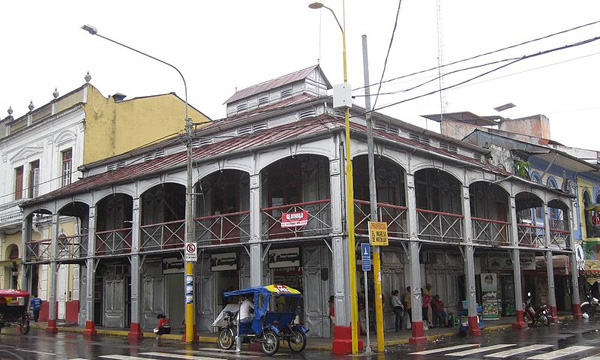There’s Ironside (an American TV series), the Iron Lady (Margaret Thatcher), the Iron Curtain, the Iron Gates (a gorge on the Danube). Real estate has now joined the club by offering us “the iron house.”
The “Casa de fierro” is in the middle of the jungle, in the streets of the city of Iquitos, Peru. The walls, ceilings and balcony are made of iron. Other metal alloys were also used.
The long veranda, which stretches along the entire façade, and numerous archways allow for better ventilation of the building, which is subject to the tropical heat. The Ulysses travel guide describes the house as a strange building. Hard to argue with that. The architecture is rather ordinary. It’s the iron that gives the building a special cachet.
Legend has it that the building is the first prefabricated house built in the Americas. How did it end up in the heart of the jungle? And where does it come from? The story is rather outlandish.
It’s the 1800s. Successive inventions by Goodyear, Dunlop and Michelin lead to the use of rubber to manufacture tires. The rubber boom is on. The material is obtained from latex extracted from the sap of the rubber tree, which is a common tree in Peru. The country experiences an economic boom because it shares the monopoly for the new industry with Brazil.
Men make fortunes. They are called the “rubber barons.” One of them happens to go to the 1889 Paris World Fair. He comes across an iron house that can be dismantled. Who’s the architect? None other than Gustave Eiffel, who designed the tower that bears his name. Eiffel wanted to sell his dismountable houses to European bureaucrats living in colonies throughout the world. Not only was Eiffel an architect and civil engineer, he was a businessman as well.
Back to the rubber baron. He buys the house and decides to ship it to Peru. The house is dismantled, put on a boat and carried through jungle once it reaches America. It’s said that a hundred men carried the iron house.
In Peru, the owner finds the house to be too big. He divides it in two. One half is found in Iquitos and is dubbed the “Casa de fierro.” The other half, erected further away, is neglected and forgotten, even though some of its parts are recycled at the central market.

The house has been bought and sold numerous times since it was erected in 1890. Today it houses a café and arouses the curiosity of tourists.
It was a traveler we met on a bus who spoke to us about Gustave Eiffel’s iron house in Peru. “It’s really something to see!” he exclaimed.